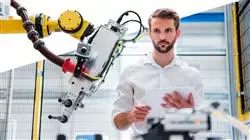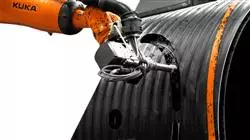University certificate
The world's largest faculty of information technology”
Introduction to the Program
Specialize in Industry 4.0 and you will be able to meet the challenge of improving communication in the field of Robotics”

Current mechanisms for interacting with robots use natural language, although it is common to reduce communication with robots to a minimal component with preprogrammed commands, using manual interfaces such as joysticks, meaning mobile applications become simpler. However, the current challenge in the field of Robotics is to achieve a much more fluid dialog between the robot and the human being.
This Postgraduate diploma provides the IT professional with all the necessary tools to achieve the mechanisms of recognition and synthesis of emotions oriented to provide the robot with a certain emotional intelligence on the one hand, and on the other, to make it capable of reacting with different emotions depending on the reactions of the users.
A challenge that will be possible thanks to the application of all the learning achieved in this program and with the help of a team of professionals specialized in the field of Robotics. This program also includes an extensive content that covers virtual and augmented reality technologies, as well as the design and modeling of robots.
This online program offers students an opportunity to achieve a preparation that will allow them to progress in their career in a field that requires creativity and highly qualified personnel. This program uses a Relearning system and multimedia content that will favor the acquisition of knowledge in an agile and comfortable way.
Join a program where you will master the modeling and simulation of terrestrial, aerial or aquatic manipulator robots”
This Postgraduate diploma in Robot Interaction Tools contains the most complete and up-to-date program on the market. The most important features include:
- Development of case studies presented by experts in robotic engineering
- The graphic, schematic, and practical contents with which they are created, provide scientific and practical information on the disciplines that are essential for professional practice
- Practical exercises where self-assessment can be used to improve learning
- Its special emphasis on innovative methodologies
- Theoretical lessons, questions to the expert, debate forums on controversial topics, and individual reflection assignments
- Content that is accessible from any fixed or portable device with an Internet connection
Boost your career with a program that adapts to you. Without fixed schedules, or in-person classes”
The program’s teaching staff includes professionals from the sector who contribute their work experience to this educational program, as well as renowned specialists from leading societies and prestigious universities.
Its multimedia content, developed with the latest educational technology, will provide the professional with situated and contextual learning, i.e., a simulated environment that will provide an immersive education programmed to learn in real situations.
The design of this program focuses on Problem-Based Learning, by means of which the professional must try to solve the different professional practice situations that are presented throughout the academic course. This will be done with the help of an innovative system of interactive videos made by renowned experts.
Enroll now in a program that will show you all the possibilities of Robotics and Industry 4.0"

Delve into the most advanced strategies in programming dialogs with robots"
Why study at TECH?
TECH is the world’s largest online university. With an impressive catalog of more than 14,000 university programs available in 11 languages, it is positioned as a leader in employability, with a 99% job placement rate. In addition, it relies on an enormous faculty of more than 6,000 professors of the highest international renown.

Study at the world's largest online university and guarantee your professional success. The future starts at TECH”
The world’s best online university according to FORBES
The prestigious Forbes magazine, specialized in business and finance, has highlighted TECH as “the world's best online university” This is what they have recently stated in an article in their digital edition in which they echo the success story of this institution, “thanks to the academic offer it provides, the selection of its teaching staff, and an innovative learning method aimed at educating the professionals of the future”
A revolutionary study method, a cutting-edge faculty and a practical focus: the key to TECH's success.
The most complete study plans on the university scene
TECH offers the most complete study plans on the university scene, with syllabuses that cover fundamental concepts and, at the same time, the main scientific advances in their specific scientific areas. In addition, these programs are continuously being updated to guarantee students the academic vanguard and the most in-demand professional skills. In this way, the university's qualifications provide its graduates with a significant advantage to propel their careers to success.
TECH offers the most comprehensive and intensive study plans on the current university scene.
A world-class teaching staff
TECH's teaching staff is made up of more than 6,000 professors with the highest international recognition. Professors, researchers and top executives of multinational companies, including Isaiah Covington, performance coach of the Boston Celtics; Magda Romanska, principal investigator at Harvard MetaLAB; Ignacio Wistumba, chairman of the department of translational molecular pathology at MD Anderson Cancer Center; and D.W. Pine, creative director of TIME magazine, among others.
Internationally renowned experts, specialized in different branches of Health, Technology, Communication and Business, form part of the TECH faculty.
A unique learning method
TECH is the first university to use Relearning in all its programs. It is the best online learning methodology, accredited with international teaching quality certifications, provided by prestigious educational agencies. In addition, this disruptive educational model is complemented with the “Case Method”, thereby setting up a unique online teaching strategy. Innovative teaching resources are also implemented, including detailed videos, infographics and interactive summaries.
TECH combines Relearning and the Case Method in all its university programs to guarantee excellent theoretical and practical learning, studying whenever and wherever you want.
The world's largest online university
TECH is the world’s largest online university. We are the largest educational institution, with the best and widest online educational catalog, one hundred percent online and covering the vast majority of areas of knowledge. We offer a large selection of our own degrees and accredited online undergraduate and postgraduate degrees. In total, more than 14,000 university degrees, in eleven different languages, make us the largest educational largest in the world.
TECH has the world's most extensive catalog of academic and official programs, available in more than 11 languages.
Google Premier Partner
The American technology giant has awarded TECH the Google Google Premier Partner badge. This award, which is only available to 3% of the world's companies, highlights the efficient, flexible and tailored experience that this university provides to students. The recognition as a Google Premier Partner not only accredits the maximum rigor, performance and investment in TECH's digital infrastructures, but also places this university as one of the world's leading technology companies.
Google has positioned TECH in the top 3% of the world's most important technology companies by awarding it its Google Premier Partner badge.
The official online university of the NBA
TECH is the official online university of the NBA. Thanks to our agreement with the biggest league in basketball, we offer our students exclusive university programs, as well as a wide variety of educational resources focused on the business of the league and other areas of the sports industry. Each program is made up of a uniquely designed syllabus and features exceptional guest hosts: professionals with a distinguished sports background who will offer their expertise on the most relevant topics.
TECH has been selected by the NBA, the world's top basketball league, as its official online university.
The top-rated university by its students
Students have positioned TECH as the world's top-rated university on the main review websites, with a highest rating of 4.9 out of 5, obtained from more than 1,000 reviews. These results consolidate TECH as the benchmark university institution at an international level, reflecting the excellence and positive impact of its educational model.” reflecting the excellence and positive impact of its educational model.”
TECH is the world’s top-rated university by its students.
Leaders in employability
TECH has managed to become the leading university in employability. 99% of its students obtain jobs in the academic field they have studied, within one year of completing any of the university's programs. A similar number achieve immediate career enhancement. All this thanks to a study methodology that bases its effectiveness on the acquisition of practical skills, which are absolutely necessary for professional development.
99% of TECH graduates find a job within a year of completing their studies.
Postgraduate Diploma in Robot Interaction Tools
Currently, robots can interact with humans through natural language. However, in most cases, communication is limited to pre-programmed commands through manual interfaces or simple mobile applications. Thus, the current challenge in the field of Robotics is to achieve a more fluid dialogue between humans and robots. For this reason, TECH has created the Postgraduate Diploma in Robot Interaction Tools, which provides IT professionals with all the necessary tools to develop emotion recognition and synthesis mechanisms, in order to provide the robot with some emotional intelligence and make it capable of reacting with different emotions depending on the user's responses. Do not miss this incredible opportunity to develop professionally in this innovative sector and enroll in this Postgraduate Diploma!
Study in a 100% online mode and without adhering to strict pre-established schedules
Through the Postgraduate Diploma in Robot Interaction Tools, you will increase your knowledge regarding the creation of robots that understand and respond emotionally to humans, which will help improve the interaction between the two and take Robotics to the next level. All this, together with a team of teachers specialized in Robotics, who have extensive experience in this professional field. Taught online, this program offers the opportunity to acquire a solid preparation in a field that requires creativity and highly specialized skills from the comfort of your home. With a Relearning learning system and multimedia content, the teaching will provide an agile and comfortable acquisition of knowledge, completely adapted to your own pace of study.







